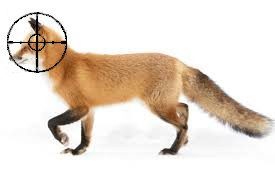

Fox Hunting a Humane Approach
Fox Hunting a Humane Approach. There is no question that foxes are a major problem in Australia on many levels. It is not, however, their fault and as living creatures if they are to be hunted, they deserve an ethical approach.
Table of Contents
Fox Hunting. I spent my teen years growing up in rural Australia. As with many of us in that environment, hunting was just something you did. You used a firearm in my case and shot any feral pest that you came across. Including that cunning predator, the fox. When you go hunting in Australia in a farmland setting it is difficult not to come across them and in this pursuit, we killed a good number.
I was not comfortable, at times, with the way we did this. There were some messy kills and it struck me that I could do it better. It is with this article that I explore some ways in which I can help advance that idea.
The problem with foxes in Australia
The European Red Fox was introduced to Australia in the 1860s for recreational hunting and rapidly spread throughout southern Australia. Their primary prey is another introduced animal, the rabbit. It did not take long, however, for the fox to acquire a taste for Australia’s native fauna.
The European Red Fox has been listed as key threat to native endangered and vulnerable species
Small marsupials, mammals and ground nesting birds are at high risk as well as lizards and frogs. Their diet is not confined to native wildlife. Poultry, lambs, goat kids and domestic pets are also killed by foxes.
The fox is officially recognized in Australia as a pest animal by causing the destruction of agriculture, wild ecosystems and natural resources.
In some cases foxes have been known to kill up to 30% of newborn lambs.
Fox Hunting Australia as a Control Method
Fox control is difficult and various methods have been employed including trapping, baiting and den fumigation. Shooting is, arguably the most humane of these control methods as long as it is done in a manner that is likely to kill instantly thereby minimising unnecessary suffering.

The most humane approach
A model has been developed under the Australian Animal Welfare Strategy for assessing the relative humaneness of fox control best practice. A worksheet of that modelling can be found here: Fox Ground Shooting Worksheet
The method that showed the least suffering was a headshot from a static position.
Various concepts can be taken from this study and I have outlined my take on what was presented.
Humane methods of shooting foxes take into account:
If the fox is within range of the firearm
Know your firearm and its limitations. If your target happens to be 300 metres and you are using your average .22 rifle then you are unlikely to even hit the object you are aiming at. Let alone placing a headshot.
Whether the target is clearly visible
This is fundamental. When hunting anything you must be able to clearly identify your target.
Use of appropriate firearm and ammunition
This should happen in the preparation stages. What are you hunting? What is the best caliber and cartridge for hunting foxes? (Check out Luke’s article on Basic Cartridge Selection)
Correct shot placement
One shot, one kill! Great in an ideal world but we know it does not always happen. The concept is to give yourself and your target the best possible chance of a clean kill.


Make sure your first target is dead before moving to the next.
Locate and dispatch any wounded animals preferably with a second shot to the head.
A final word
With these factors of humane fox hunting considered, there are lots of other things to help with a successful hunt. We will cover legal requirements, safety, where to go and equipment in other articles. Read on.
Further information may be found here Standard Operating Procedure – FOX003
The PestSmart website provides information about invasive vertebrate pests in Australia: their biology, ecology, impacts and best practice management. It is based on the latest science, evidence and knowledge.
PestSmart is managed through the Centre for Invasive Species Solutions (CISS) which is a national collaborative research, development and extension organisation, formed to tackle the ongoing threat from invasive species.
Want the right rifle for your needs? Check out this article. You should probably decide on the cartridge first, it may help you along your quest.
FAQ (Frequently Asked Questions)
Can you shoot a fox with a 22 rimfire?
- Higher velocity ammunition, such as the .22 Winchester Magnum Rimfire or the .17 Hornady Magnum Rimfire.
- Range within 50m, any further and you are unlikely to get a humane kill.
- Head Shot, again, looking for that humane kill.
Can you shoot foxes in Australia?
Yes. All shooters must be appropriately licensed. Landowners can shoot foxes on their own land. Recreational shooters must gain permission from private landowners to hunt. On most public lands shooting of foxes is prohibited. Keep in mind Australian states have their own regulations. New South Wales for example does allow regulated shooting in some areas.
What time is best to hunt a fox?
At dusk and just after dawn. Night time is also a good time by spotlight, night vision or thermal optics. It is not impossible to hunt them during daylight hours but it depends on their prey. If their food source is around at a particular time of day then that is when the fox will be most active.
What is the best spotlight for foxes?
Foxes are what you might call color blind, therefore can not tell the difference between red and green. Known as Dichromatic Vision. Spotlights with warmer temperature such as halogen spotlights will be less disturbing to the fox. (This is also why red filters are used on spotlights.) This can mean that the target may remain still, allowing time for a better shot.
More on Spotlights.
